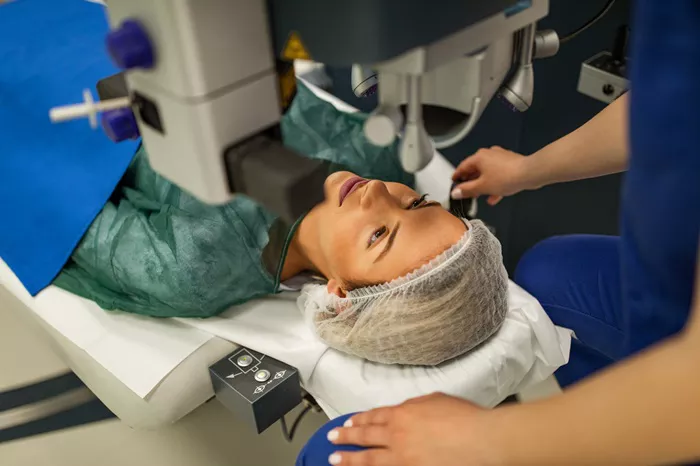Eye bags, or the puffiness that develops under the eyes, are a common cosmetic concern. They can make a person appear tired or older than their actual age. As people age, the skin loses elasticity and fat deposits can accumulate under the eyes. Many seek solutions, ranging from creams and lifestyle changes to more invasive procedures like surgery. One question often arises: Can you get eye bag surgery on the NHS? This article explores this issue in depth, providing insights into the criteria for surgery, the process, and alternatives.
Understanding Eye Bag Surgery
What is Eye Bag Surgery?
Eye bag surgery, also known as lower eyelid blepharoplasty, involves removing excess fat and skin from the lower eyelids. The goal is to create a smoother, more youthful appearance. This procedure can also address sagging skin and muscle laxity. Eye bag surgery is generally performed under local anaesthetic and can take about one to two hours.
Why Do People Consider Eye Bag Surgery?
People consider eye bag surgery for various reasons, including:
Aesthetic Improvement: Many want to enhance their appearance and feel more confident.
Age-Related Changes: As people age, the skin loses its firmness, leading to bags under the eyes.
Genetic Factors: Some individuals may have hereditary predispositions to under-eye bags.
NHS Criteria for Eye Bag Surgery
Eligibility for Surgery
The National Health Service (NHS) has specific criteria for procedures like eye bag surgery. Not everyone qualifies. The NHS typically covers surgery if it is deemed medically necessary. Here are some factors that influence eligibility:
Medical Necessity: If eye bags cause functional problems, such as obstructed vision, surgery may be covered.
Age: Younger patients may find it harder to qualify unless there are significant medical issues.
Other Treatments: Patients may need to demonstrate that they have tried non-surgical treatments without success.
Consultation Process
If someone believes they qualify for NHS eye bag surgery, the first step is to consult a general practitioner (GP). The GP will evaluate the individual’s condition and determine if a referral to an ophthalmologist or plastic surgeon is warranted. During this consultation, the following aspects are typically assessed:
Medical History: The doctor will review any past medical issues, surgeries, or allergies.
Physical Examination: A thorough examination of the eyes and surrounding area will be conducted.
Decision-Making
Once referred, the specialist will further evaluate the patient. They may use various diagnostic tools to assess the extent of the problem. After a comprehensive evaluation, the specialist will decide if surgery is appropriate. If approved, the patient will be placed on a waiting list for the procedure.
See also: How to Get Rid of Eye Bags with Spoons?
The Surgical Procedure
What to Expect Before Surgery
Before the surgery, patients may undergo several steps:
Preoperative Assessment: This includes tests like blood work to ensure overall health.
Discussion of Risks: The surgeon will explain potential risks and complications, including scarring and infection.
Pre-Surgery Instructions: Patients may receive specific instructions about medication, diet, and what to expect on the day of surgery.
The Day of Surgery
On the day of the procedure, patients typically arrive at the hospital and prepare for surgery. This includes:
Administration of Anaesthetic: Local anaesthetic is commonly used, but sedation may be offered.
Surgical Technique: The surgeon will make small incisions, usually hidden in the lower eyelid, to remove excess fat and skin. In some cases, they may also tighten underlying muscles.
Recovery Process
Recovery from eye bag surgery can vary from person to person. Patients can expect:
Swelling and Bruising: These are common and can last from a few days to a couple of weeks.
Follow-Up Appointments: The surgeon will schedule follow-ups to monitor healing and address any concerns.
Activity Restrictions: Patients are usually advised to avoid strenuous activities and sun exposure for a specific period.
Risks and Complications
Potential Risks
As with any surgical procedure, eye bag surgery carries risks. Common complications may include:
Infection: While rare, infections can occur.
Scarring: Although incisions are typically hidden, some scarring may be visible.
Vision Problems: In very rare cases, patients may experience vision changes.
Managing Risks
To minimize risks, patients should:
Choose a Qualified Surgeon: Ensure that the surgeon is certified and experienced.
Follow Preoperative Instructions: Adhering to guidelines can improve outcomes.
Attend Follow-Up Appointments: Regular check-ups can catch potential complications early.
Alternatives to Surgery
Non-Surgical Options
For those who do not qualify for NHS eye bag surgery or prefer non-invasive methods, several alternatives exist:
Injectables: Dermal fillers can help reduce the appearance of bags by adding volume and smoothing skin.
Laser Treatments: Laser therapy can tighten the skin and improve texture.
Topical Treatments: Creams and serums designed for under-eye use may provide temporary relief.
Lifestyle Changes
In some cases, lifestyle changes can help manage the appearance of eye bags. Suggestions include:
Adequate Sleep: Ensuring proper rest can reduce puffiness.
Hydration: Drinking enough water can help maintain skin elasticity.
Diet: A balanced diet rich in vitamins can contribute to overall skin health.
Conclusion
Eye bag surgery can significantly improve the appearance of those struggling with under-eye bags. However, obtaining the procedure through the NHS requires meeting specific medical criteria. Patients should consult with their GP and follow the referral process for assessment. For those who do not qualify, various non-surgical options exist to address this common concern. Whether through surgery or alternative treatments, addressing eye bags can lead to improved self-esteem and a more youthful appearance.
Related topic:
Does Gua Sha Get Rid of Eye Bags?
Can Vicks Vaporub Be Used For Undereye Bags?
Can Preparation H Get Rid of Eye Bags?


